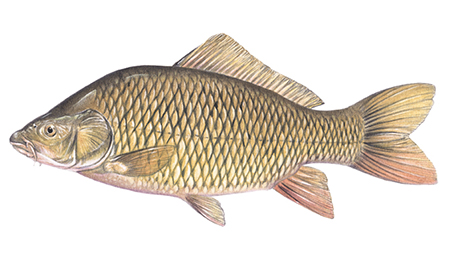Common Names: Carp, German carp, European carp
Habitat
Not native to North America, carp were introduced to Ontario by Europeans as pond fish and due to its popularity as a food fish. While records vary, it is suspected that carp were introduced during the 1880s and have spread through various waterways and now inhabit many of the waters in southern Ontario. Carp are usually found in shallow weedy bays. They can have detrimental effects on native fish species and on duck populations due to the uprooting of plants while feeding, increasing the turbidity of the water.
Spawning Patterns
Spawning occurs when water temperatures reach 17 ºC (62 ºF) usually corresponding with late spring and early summer. Spawning has been recorded as late as August in the Great Lakes. A couple of females, as many as three, move into shallow weedy bays and are accompanied by up to fifteen males. A single female may produce over 2 million eggs.
Diet
Unlike most other species of fish, carp are omnivorous (they eat both plants and animals). They will pick up a mouthful of the water’s substrate, spit it out into the water and pick out any food items. Their diet normally consists of aquatic insects, snails, algae, wild rice and the seeds of aquatic plants.
Age and Size
Seldom do carp exceed the age of 20. The spawning population usually consists of members between the ages of 2-16. In the first year alone it is possible for the fish to reach lengths of 20 cm (7.5”). Carp have the potential to grow to great sizes; commercial and scientific nets have captured carp in the 35-50 lbs range.
Fishing Tips
Carp are best caught during the spawning period when it is common for the fins to be visible above the water. Fish may take lures but it is more common for anglers to use baits such as worms or dough-balls.
Fish illustration ©CURTIS ATWATER (www.natureartists.com/atwaterc.htm)









